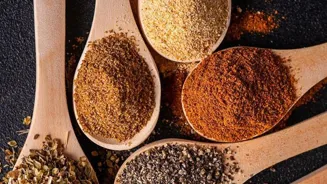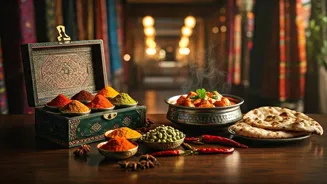Unveiling 8 Unique Ingredients to Elevate Your Cooking Experience - Dive into a world of culinary gems that promise to transform your dishes. Discover the unexpected and tantalize your taste buds with
these exotic flavors
In the bustling kitchens of India, where generations have perfected the art of flavor, a new wave of culinary explorers is emerging. These home chefs and food enthusiasts are not content with the usual suspects – the familiar turmeric, cumin, and coriander.
They are venturing beyond the spice rack, discovering and embracing unique ingredients that promise to elevate everyday cooking to a gastronomic adventure.
This article unveils eight such ingredients, readily available in India, which can add depth, complexity, and a touch of the unexpected to your vegetarian dishes. Get ready to tantalize your taste buds and impress your family and friends with these culinary gems.
These ingredients, often overlooked, can truly transform your simple dishes.
Imagine adding a subtle, almost floral note to your sambar with a few strands of kokum. Or surprising your guests with the earthy, truffle-like aroma of black salt in your raita. The possibilities are endless.
This isn't about replacing your go-to spices, but about expanding your culinary horizons and adding new dimensions to your favorite recipes. So, ditch the monotony and embark on a flavorful journey with these eight unique ingredients. Prepare to spice up your life.
Kokum: The Tangy Twist from the Konkan Coast
Kokum, a souring agent derived from the fruit of the Garcinia indica tree, is a staple in Konkan cuisine. Its deep purple hue and tangy flavor make it a versatile ingredient that can enhance a variety of dishes.
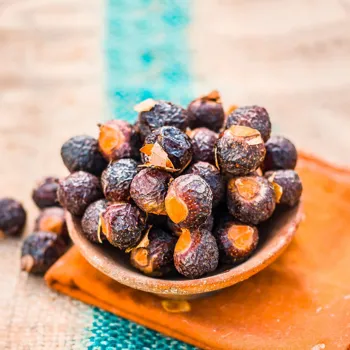
Unlike tamarind, kokum offers a slightly sweeter and less acidic tang, making it a milder alternative. It is available in dried form and can be added to dals, curries, and even refreshing summer drinks. Kokum is packed with antioxidants and is known for its digestive properties.
To use it, simply soak the dried kokum pieces in warm water for about 15-20 minutes to rehydrate them and release their flavor. The infused water can then be added to your dish, and the softened kokum can be discarded or added for a more intense flavor.
Experiment with kokum in your kadhi, sambar, or even as a marinade for vegetables before grilling or roasting. Its distinct flavor profile will undoubtedly add a unique twist to your culinary creations. Don't be afraid to use it in small quantities initially.
A small amount of kokum can make a surprisingly big difference to your recipes. The dried form is easily available in most Indian grocery stores. The distinctive flavour of kokum is worth having in your kitchen. It adds a special touch to traditional meals.
Kokum's tangy character is perfect for balancing sweet and savoury notes. With just a small amount of this fruit, you can increase the flavors of your foods.
Kokum improves the overall appeal of food thanks to its vibrant, fruity flavour and colour.
It's rich in antioxidants and helps digestion, making it a healthy addition to any meal. Kokum can be particularly useful in providing depth and personality to lighter, more vegetarian fare. Learning how to incorporate kokum into your meals will make them more delicious and nutritious.
Kokum's distinct flavor brings a new level of taste to traditional Indian cooking. It adds a distinct twist to vegetarian curries, drinks, and meals, making every bite taste better.
The subtle sourness is unique, not like lemon or tamarind. Use it where you want extra tart flavour.
Start small; you can always add more. Kokum is known for its health benefits, assisting in digestion. It's a versatile item that may be utilized to improve any recipe. Its rich flavor can turn any dish into a distinctive culinary experience.
Black Salt (Kala Namak): The Smoky Mineral Wonder
Black salt, also known as kala namak, is a volcanic rock salt with a distinctive sulfurous aroma and taste. Despite its name, it is not black but rather pinkish-grey in color. It is widely used in Indian cuisine, particularly in chaats, raitas, and fruit salads.

The unique flavor of black salt comes from the presence of sulfur compounds, which give it an almost egg-like taste. This makes it a popular ingredient in vegan cooking, where it can be used to mimic the flavor of eggs in dishes like tofu scramble or vegan egg salad.
Black salt also aids in digestion and is believed to have cooling properties. To use black salt, simply sprinkle it over your dish as a finishing salt. Be mindful of its strong flavor and use it sparingly. A pinch of black salt can add a surprising depth and complexity to even the simplest dishes.
Try it on your next fruit platter, or use it to season your potato salad for an unexpected twist.
Black salt is a must-have for every cook because of its remarkable flavour. It is useful in salads, raitas and more of foods. A dash can completely improve a recipe's enjoyment.
Black salt is well known for digestive qualities. As a result, it's a healthy way to add depth to meals. It could make eating an even more pleasurable experience if you simply experiment with it in your daily activities. Use it to season meals for a little bit of excitement.
Its distinct flavor enhances regular meals. Add to fruit salads, yogurts, and other foods. For a more delicious flavor, use it sparingly. Its unique aroma will amaze your family and friends. It will add a depth of flavor to your culinary productions.
This addition to your spice cabinet will enhance the flavor of your meals.
Black salt's unique taste sets it far apart from normal table salt. It offers more than just salinity; it's a burst of savory taste. To enjoy its benefits, experiment with using smaller amounts initially.
Its aroma makes it the perfect option for flavoring different meals. It adds a unique dimension to cooking that is appreciated by both cooks and diners.
Gondh (Edible Gum): The Nutrient-Packed Thickener
Gondh, also known as edible gum or tragacanth gum, is a natural gum derived from the sap of various Middle Eastern and Asian plants. It is commonly used in Indian cuisine, particularly in winter delicacies like gondh ke laddu.
Gondh is known for its ability to provide warmth and energy, making it a popular ingredient in traditional remedies and sweets. It is also a good source of calcium and protein. When heated, gondh puffs up and becomes light and airy, adding a unique texture to dishes.
To use gondh, first fry it in ghee until it puffs up. Then, add it to your recipes, such as laddus, chikkis, or even as a topping for kheer. Gondh not only adds nutritional value but also lends a delightful crunch and a subtle nutty flavor to your dishes.
Its unique properties make it a versatile ingredient for both sweet and savory preparations.
During the winter, the sweet has many advantages. Gondh has a unique texture. Gondh is the perfect addition to meals for a good taste and feel. Gondh works nicely in Indian dishes like gondh ke laddu.
Gondh are a well-known source of energy and minerals. These treats give flavor, crunch, and health advantages to meals.
It improves taste and well-being in equal measure. It's found in many winter sweets. Gondh provides warmth, energy, and flavour.
By growing it, you can make your meals a lot better. Be mindful to fry gondh in ghee until they rise. This addition improves the taste and crunch of your meals.
Gondh makes old dishes better and tastes better. It's not just tasty; it also has lots of minerals.
Use gondh to make Indian sweets more flavorful and healthful. It makes foods better and more nutritious. If you're creative with cooking, you can see how well gondh fits into recipes.
Dried Fenugreek Leaves (Kasuri Methi): The Aromatic Herb
Kasuri methi, or dried fenugreek leaves, is an essential ingredient in Indian cooking. Its slightly bitter and aromatic flavor adds a unique depth to curries, dals, and vegetable dishes. Unlike fresh fenugreek leaves, kasuri methi has a more concentrated flavor and a longer shelf life.
It is a good source of iron, fiber, and other essential nutrients. To use kasuri methi, simply crush it between your palms to release its aroma and add it to your dish towards the end of cooking. Roasting the kasuri methi lightly before crushing it can further enhance its flavor.
Kasuri methi pairs well with potatoes, paneer, and lentils. It can also be used to flavor breads like naan and paratha. A sprinkle of kasuri methi can transform a simple dish into a flavorful and aromatic delight. Ensure they are lightly toasted before using to bring out enhanced flavor.
It gives a unique taste to vegetarian foods. A staple in dishes and lentil-based meals. These leaves give a unique flavour. Kasuri methi is packed with minerals, especially iron. Before using, rub it between the palms to release its scent. It gives the meal an additional flavor.
This humble flavour can greatly elevate any meal.
Kasuri methi infuses meals with a distinct complexity. With its slightly bitter flavour, it's the perfect addition to any recipe. This provides fragrance and flavour elevation. It gives great flavor to foods. This herb is nutritious.
Kasuri methi elevates the taste of your dishes.
Adding dried fenugreek leaves will make your food more delicious. Its subtle flavor makes meals taste better. These leaves will definitely be a staple in your kitchen. They give warmth to anything you prepare. Use the flavors to enhance dishes.
Stone Flower (Pathar Phool): The Earthy Lichen
Pathar phool, also known as stone flower, is a type of lichen that grows on rocks and trees. It is a staple spice in Maharashtrian and Hyderabadi cuisine, prized for its earthy and woody aroma.

Pathar phool has a delicate, almost floral flavor when cooked, adding a unique depth to meat dishes, curries, and biryanis. To use pathar phool, lightly roast it in a pan until it becomes fragrant. Then, grind it into a powder and add it to your dish along with other spices.
Be careful not to over-roast it, as it can become bitter. Pathar phool is often used in spice blends like garam masala and goda masala. Its distinct flavor profile adds a touch of the wild to your culinary creations.
Finding authentic pathar phool might require a visit to specialty spice shops or online retailers.
It imparts a rustic undertone to meals. This is a staple in dishes. Stone flower offers a woodsy aroma that will enhance any dish. It is essential to carefully toast and grind before adding.
This gives flavors to any kind of food. With this unusual addition, you can uplift taste. With a touch of wild taste, turn meals into a memorable experience.
It gives recipes an amazing flavour. Not only does the stone flower improve taste, but it also gives foods an unforgettable flavour.
Don't roast it excessively since it becomes intense. Stone flower must be added to a variety of recipes for a rich, aromatic depth. It's a vital component that gives a unique accent to any recipe.
Stone flower adds a layer of complexity.
Due to its amazing flavour, regular foods transform into something spectacular. It imparts an unforgettable depth and complexity. By experimenting with this material, you can uplift your dishes. Its natural flavor is amazing.
Star Anise (Chakra Phool): The Licorice-Scented Spice
Star anise, with its distinctive star shape and licorice-like aroma, is a spice derived from the fruit of the Illicium verum tree. It is widely used in Indian, Chinese, and Vietnamese cuisine. Star anise adds a warm, sweet, and slightly spicy flavor to dishes.
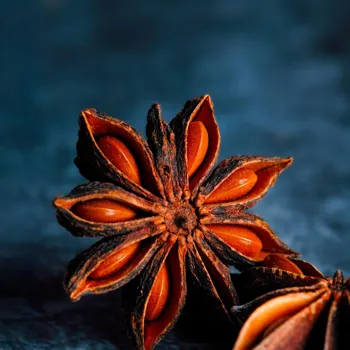
It is commonly used in biryanis, curries, and soups. Star anise also has medicinal properties and is believed to aid in digestion and relieve coughs.
To use star anise, you can either add the whole star to your dish during cooking and remove it before serving, or grind it into a powder and use it as a spice. A little star anise goes a long way, so use it sparingly.
Its unique flavor profile can add a touch of elegance and sophistication to your culinary creations. Experiment using in traditional recipes to experience new flavours.
It is used in food. It smells like liquorice. Star anise gives warmth and is delicious. This element is for taste.
It enhances any formula. Star anise has properties to heal with. It is for the food.
Star anise is great at giving dishes a new complexity of flavour. It gives foods a mild spice and flavour as well. The taste of spices is sweet and fragrant. For an enhanced experience, try it in new dishes.
To appreciate it, experiment with using smaller levels initially.
Star anise has a fragrant addition. Infuse soups to add taste. It tastes sweet and wonderful. You may use it to enhance cooking with flavor and a hint of appeal. For an uplifting impact on the foods, experiment with cooking.
Rose Water (Gulab Jal): The Floral Essence
Rose water, derived from steeping rose petals in water, is a fragrant liquid that adds a delicate floral aroma and flavor to dishes. It is commonly used in Indian sweets like gulab jamun, rasgulla, and lassi.
Rose water is also used in beverages and desserts in Middle Eastern and Mediterranean cuisine. It is believed to have cooling properties and is often used to soothe skin and reduce inflammation.
To use rose water, simply add a few drops to your dish towards the end of cooking or as a finishing touch. Be careful not to add too much, as it can overpower the other flavors. Rose water can also be used to flavor homemade ice cream, cakes, and puddings.
Its subtle floral essence can add a touch of romance and elegance to your culinary creations. It makes your dessert more delightful.
It gives a fragrance to the dishes. You will use rose water in Indian sweets. The ingredient comes with flavors. It is often added to beverages or desserts.
Rose water is used to provide fragrance. If you cook, this ingredient is good.
With this food, taste the fragrance. It gives a wonderful smell and taste. The rose water gives a good feeling. It mixes well with desserts and drinks. The ingredient can uplift aroma in foods.
The element adds a touch of class. Not just because it smells good, but rose water has other functions. Its sweet element adds an emotional touch. This helps for uplifting treats. It contributes for the cuisine by taste.
Saffron (Kesar): The Golden Spice
Saffron, derived from the Crocus sativus flower, is the world's most expensive spice. Its vibrant red color, delicate aroma, and distinctive flavor make it a highly prized ingredient in Indian cuisine. Saffron is used to flavor and color dishes like biryani, kheer, and kesari bath.
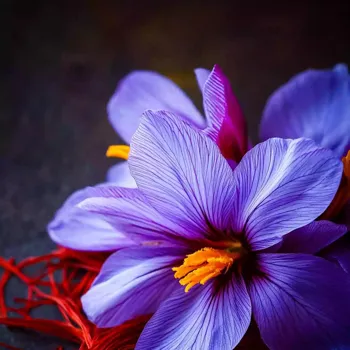
It is also believed to have medicinal properties and is used in traditional remedies for mood elevation and antioxidant boost. To use saffron, soak a few strands in warm milk or water for about 30 minutes to extract its color and flavor.
Then, add the infused liquid to your dish towards the end of cooking. A little saffron goes a long way, so use it sparingly. Its golden hue and delicate flavor can transform a simple dish into a luxurious and unforgettable culinary experience.
Store in an airtight container in a cool, dark place to maintain the freshness.
It is a very costly spice. It helps with flavoring foods like biryani. The component comes as a flavor and hue. Saffron has some health use as well. For best taste, just steep in warm.
With a slight use, enhance the flavors. It is a flavor that gives a luxurious touch.
Saffron changes cuisines. Enhance any recipe to make something special. It contains a flavour that increases pleasure and happiness. Saffron gives a special and lasting flavor to every dish.
Saffron makes your creation taste better.
When saffron is present in the meal, it is tasty. It is for flavour and it changes meals. Prepare dishes using this golden element. Its colour and its delicate taste will improve food. The element turns meals better by flavor.


